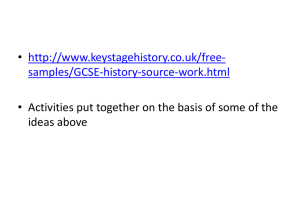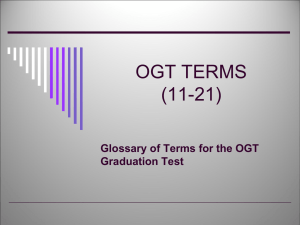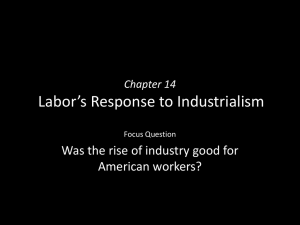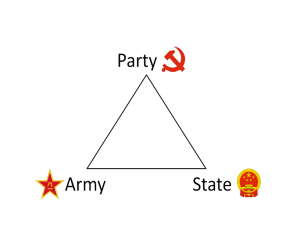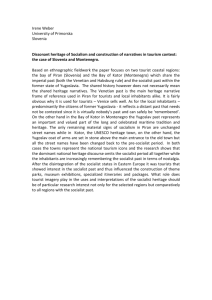PANEL 1: THE 1920S - Anglo-American conference of historians
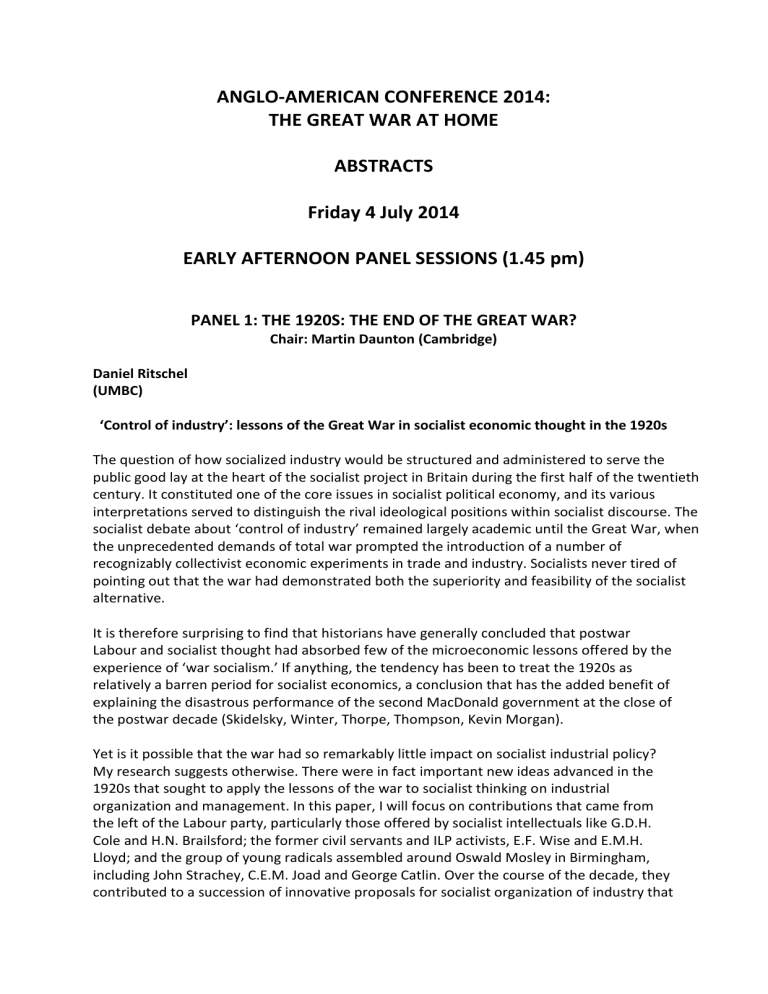
ANGLO‐AMERICAN CONFERENCE 2014:
THE GREAT WAR AT HOME
ABSTRACTS
Friday 4 July 2014
EARLY AFTERNOON PANEL SESSIONS (1.45 pm)
PANEL 1: THE 1920S: THE END OF THE GREAT WAR?
Chair: Martin Daunton (Cambridge)
Daniel Ritschel
(UMBC)
‘Control of industry’: lessons of the Great War in socialist economic thought in the 1920s
The question of how socialized industry would be structured and administered to serve the public good lay at the heart of the socialist project in Britain during the first half of the twentieth century. It constituted one of the core issues in socialist political economy, and its various interpretations served to distinguish the rival ideological positions within socialist discourse. The socialist debate about ‘control of industry’ remained largely academic until the Great War, when the unprecedented demands of total war prompted the introduction of a number of recognizably collectivist economic experiments in trade and industry. Socialists never tired of pointing out that the war had demonstrated both the superiority and feasibility of the socialist alternative.
It is therefore surprising to find that historians have generally concluded that postwar
Labour and socialist thought had absorbed few of the microeconomic lessons offered by the experience of ‘war socialism.’ If anything, the tendency has been to treat the 1920s as relatively a barren period for socialist economics, a conclusion that has the added benefit of explaining the disastrous performance of the second MacDonald government at the close of the postwar decade (Skidelsky, Winter, Thorpe, Thompson, Kevin Morgan).
Yet is it possible that the war had so remarkably little impact on socialist industrial policy?
My research suggests otherwise. There were in fact important new ideas advanced in the
1920s that sought to apply the lessons of the war to socialist thinking on industrial organization and management. In this paper, I will focus on contributions that came from the left of the Labour party, particularly those offered by socialist intellectuals like G.D.H.
Cole and H.N. Brailsford; the former civil servants and ILP activists, E.F. Wise and E.M.H.
Lloyd; and the group of young radicals assembled around Oswald Mosley in Birmingham, including John Strachey, C.E.M. Joad and George Catlin. Over the course of the decade, they contributed to a succession of innovative proposals for socialist organization of industry that
ranged from pioneering versions of the idea of a ‘mixed’ economy of public and private ownership; through the technocratic model of the ‘public corporation,’ first elaborated on the socialist side by Strachey and Emmanuel Shinwell in their detailed scheme for the reorganization of the coal industry early in 1928; to the ambitious blueprint for a centrally planned economy offered towards the end of the decade by the Mosley group, with the initial backing of many on the left, including Wise, Cole, and Brailsford.
Though their microeconomic proposals failed for various reasons to secure wider support within the Labour party in the 1920s, they all drew directly on the rich precedents established by the war economy and can be shown to have laid the groundwork for much of the thinking on industrial policy within the Labour party in the 1930s and beyond.
Reba Soffer
CSUN
Reality and fiction: the newer men and the newer women
The demise of a long and anachronistic 19 th century, accelerated after 1918 by the appearance of new institutions, eroded social and economic verities, and political uncertainties, challenged national perceptions of personal and public life. The horrific loss of nearly a whole generation of young men was compounded by the diminution of Britain’s international status and economic dominance. Inadequate public and private responses to problems of inclusion and exclusion were increasingly challenged in party platforms and the printed word. A wide-spread consensus in circles high and low despaired that the cessation of fighting was a hollow victory.
Although everything about the war and its after effects were unprecedented, events beginning in 1924 were even more problematic because of their deeply ambiguous meanings. That year, the brief success and failure of the Labour Party to form a government competed for attention with the opening of the British Empire Exhibition, a testimony to optimism in a future that did not seem promising to large numbers of the population. The
July 1925 “Red Friday” agreement granting a subsidy to the coal industry to maintain wage levels for 9 months during a Royal Commission inquiry, concluded in 1926 in the first
General Strike in British history. That episode, a complete failure for the coal miners and their allies, led to the Trade Disputes and Trade Unions Act of 1927 that crippled the Trades
Unions until 1946. In 1928 the electorate trebled as all women over 21 were given the vote.
The first Labour government was elected in 1929, followed quickly by the depression. But the full effects of the depression were not felt until the1930’s, when new domestic and international conflict once again confronted conventional British thinking.
What were the principal influences upon thought as these events unfolded, and how do we best access them? Before the 1930’s when oral history was launched systematically, and we could hear surviving voices and experiences, there was popular, best-selling fiction read by new middle-brow—not to be conflated with middle-class—readers. Beginning in 1924, readers turned away from the memoirs, poetry and novels that concentrated upon domestic and international war experiences to read detective fiction and outré social satire.
Among these enormously popular authors, there are , I believe, three who provided discussions of class, society, and tradition that resonated significantly among their British readers. Michael Arlen was an Armenian roué born in Bulgaria in 1895 as Dikran
Kouyoumdjian, who successfully portrayed a romanticized version of British life in his The
Green Hat (1924) that led to 2 plays, 2 motion pictures, and his picture on the cover of Time magazine. Dorothy Sayers invented a perfect detective, Lord Peter Wimsey, in an impeccably aristocratic setting. And finally, Agatha Christie, published millions of copies of her detective fiction that were translated into scores of plays and movies, that reached an even greater audience. I am interested only in her female characters because they most reflected the changed times. After 1929, although each of these writers continued to publish, their messages and their audience changed.
Frank Prochaska
University of Oxford
The Monarchy and the end of the Great War
Abstract not available
PANEL 2: BRITISH HOME FRONT MASCULINITIES
Chair: Michael Roper (Essex)
Catherine Feely
University of Derby
‘Don’t think I read only novels’: gendered understanding of the reading of imprisoned conscientious objectors in Britain, 1916-1919
When the Military Services Act introduced conscription in 1916, around 16,000 men applied for exemption from service on the grounds of ‘conscientious objection’. However, in practice, very few men were exempted and around 6,000 men who refused to serve as noncombatants or take up essential work for the war effort, were court-martialled and imprisoned. Many of these men objected on either moral or political grounds and were already members of religious or political communities. Reading – of either the Bible or of political literature – and education was often a key element of their identity.
Focusing on a number of case studies of imprisoned COs, this paper discusses how men coped with being denied control over their reading and writing in prison. To many of these men, restrictions on reading and the prohibition of writing materials was, far from being a trivial matter, one of ‘the worst features of prison life’ (Hobhouse and Brockway, 1922).
When combined with the physical conditions of the prison cell and the restriction of reading material, being unable to make proper notes made sustained reading difficult and frustrating, if not impossible. This lack of control over reading and writing became symbolic of how conscientious objectors were not only stripped of their freedom by the Military
Services Act, but their ability to control their own destinies. While COs complained about the very real difficulties and isolation of reading in prison, however, they found ways to cope with them and, through their use of literature, to reassert their rights to selfdetermination and self-expression.
This paper explores how the reading practices of conscientious objectors were gendered both by their detractors and in their own letters and prison memoirs While conscientious objectors were often caricatured as weak and effeminate bookworms, COs themselves used gendered metaphors to describe their reading, stressing a preference for ‘purposeful reading’ of non-fiction or devotional books rather than novels, which were often denounced as trivial, self-indulgent and explicitly feminine. This paper will propose that in describing the bodily and mental struggle to learn and read in prison, conscientious objectors created alternative understandings of masculine reading, to which ideas of control and sacrifice – rather than escape and imagination – were central.
Jessica Meyer
University of Leeds
‘And they say a woman could do our work!’: medical orderlies in British Home hospitals in the First World War
During the First World War over 1,600 hospitals were run on British soil for the treatment of wounded servicemen. They included established military hospitals, Territorial Force (TF) general hospitals and hundreds of auxiliary hospitals. The military and TF hospitals were staffed by the Royal Army Medical Corps (RAMC), the Queen Alexandra's Imperial Military
Nursing Service (QAIMNS) and Voluntary Aid Detachments (VADs) supplied by the Joint
Committee of the British Red Cross and the St. John’s Ambulance Association. Auxiliary hospitals were supervised by the RAMC, which provided medical officers, but were run almost entirely by the Red Cross.
While the role of women, as VAD members and professional nurses, and of the RAMC doctors providing professional oversight in hospitals, is comparatively well-known, the role of the RAMC Other Ranks serving in military and TF hospitals has remained largely unexamined. Yet a large group of men worked in these hospitals, carrying out tasks that were essential to their smooth running. Non-commissioned officers held important administrative roles, while rankers served as medical orderlies, functions that, as men in wartime, placed them in a liminal gender space. They served with the RAMC under military discipline, yet they answered to female nurses who had authority over them. They undertook tasks such as cleaning, which were associated with ‘women’s work’, while at the same time doing heavy lifting and transport that nurses were deemed physically unsuited for. In constant contact with combatants who had suffered from the physical and emotional penalties of combat, they were themselves non-combatant. And, serving in Britain, they were constantly faced with the accusation that, despite the fact that they wore a uniform, they were shirking their duty to the nation.
This paper seeks to recover the voice of the British home-based medical orderly for the historical record and, in doing so, to uncover some of the questions surrounding his sense of gendered selfhood. Using the hospital journals of three TF hospitals in which the status and role of the orderly is reflected through contributions by patients, nurses and the orderlies themselves, this paper examines how these men defined themselves and were defined by others as men and servicemen in wartime. It thus explores both subjective understandings and cultural representations of the impact of war on the gender identity of men whose roles required them to remain at home and give care rather than engage in combat overseas.
Laura Ugolini
University of Wolverhampton
Civilian men, home front volunteering and masculinity in England, 1914-18
In recent years, women’s and gender history have had a significant impact on the history of the First World War. Historians of masculinity, for example, have shed new light on British
(and indeed, other) combatants’ varied attitudes towards service in the armed forces, as well as on the often ambivalent relationship between Edwardian notions of ‘manliness’ and military values. However, we know far less about the two thirds of British men who did not enter the armed forces during the conflict: we still know little about how the war affected civilian men’s lives and identities in Britain, and about the extent to which ‘normal’ practices and relationships were disrupted.
This paper, drawn from a wider project that explores middle-class civilian men’s lives on the
English home front during the First World War, aims to shed some light on civilian men’s identities and experiences. Focusing on volunteer activities on the home front, it considers middle-class men’s motives for – and experiences of – joining organisations such as
Volunteer Training Corps and special constables. The paper thus examines the understandings of manly conduct that led middle-class men to volunteer their services on the home front, and questions whether their actual experiences lived up to expectations, enabling them to gain a sense that they were making a manly contribution to the war effort.
The paper will focus on two of the most common volunteering choices made by middle-class men: enlistment in the Volunteer Training Corps and the special constables. It will begin by considering men’s motives for joining up, paying particular attention to the extent to which this may have been seen as an alternative to service in the armed forces. It will then turn to official attitudes and popular perceptions, suggesting that volunteers’ status as civilians in uniform, their age and physiques all proved problematic, laying them open to ridicule and contempt. The paper will the conclude by assessing the extent to which volunteering on the home front lived up to the initial high ideals, providing middle-class men with a way of proving their status as ‘manly’ civilians.
PANEL 3: CONFLICT AND RECONCILIATION IN IRELAND’S MEMORY OF THE
WAR
Abstracts not available
Catriona Pennell
University of Exeter
The politics of contested memory: the memorials to the 36 th (Ulster) and 16 th (Irish) divisions on the Somme
Richard Grayson
Goldsmiths, University of London
Myth and the Battle of Messines, June 1917: building a new memory of Ireland’s Great
War
Paul Taylor
Independent scholar
Reality and remembrance: experiences of World War One veterans in the south of Ireland in the 1920s
PANEL 4: THE GREAT WAR IN THE ENGLISH LAKE COUNTIES: A MISCELLANY
Chair: Angus Winchester (Lancaster) and Corinna Penistorn-Bird (Lancaster)
Chris Brader
Cumbria Archives
The state and the cinema in wartime Carlisle
The virtual nationalisation of the drinks industry in certain British munitions areas has been discussed by historians, not least in the case of the State Management Scheme in Carlisle.
However, what has been little remarked upon is state involvement in the provision of cinema in the area during the First World War. In an attempt to curb excessive drinking, which was alleged to have been affecting munitions production at the nearby Gretna explosives factory, the Government took over the sale and distribution of alcohol, and introduced ‘model’ pubs. The Ministry of Munitions also addressed the ‘drink problem’ by attempting to divert workers away from pubs in Carlisle by providing alternative leisure facilities, including cinema, much to the anger of the film industry. An editorial in the film trade paper Biopic thundered: ‘No Room for State Cinema’ in 1916. Additionally, debates over wartime cinema also focussed on film content and fears over cinema as a site of immorality. In the Carlisle area one of the main contemporary worries was the composition of a large part of the local audience – young female workers, many in their teens, who had been drafted into the area to work in the nearby cordite factory. What was shown on the screen continued and amplified pre-war debates about the future of cinema. This paper looks at the provision of cinema in the Carlisle area in the First World War and the different ways it was promoted by the state and the commercial film industry.
Jane Platt
University of Lancaster
Reverend Simpson’s War: the rector of Caldbeck and the local community, 1914-1918
At the beginning of the Great War the Anglican Church assured the British that God was on their side, but during the heavy military losses of 1915 it faced criticism, religious doubt and outright secularism. As a result, Archbishop Randall Davidson inaugurated his ‘National
Mission of Repentance and Hope’, a traditionally Christian means of expiating a country’s sin which blamed military failure on the godlessness of the British people. In so doing, the
Church issued what was tantamount to a slap in the face to those soldiers and their families who had heeded the initial cries to rise up against a brutal and barbaric Germany. Later churchmen acknowledged that the Mission was a grave practical blunder; some even thought it an unmitigated disaster.
The paper follows the course of the war as it appeared in the parish magazine edited by
William Simpson, rector of Caldbeck. Parish clergy often coordinated the local war effort, their parish magazines playing a central role in supporting and encouraging their communities. In marked contrast to the pessimism of the Mission, Simpson paralleled a narrative of heroism successfully employed by the secular press through following the
progress of his Caldbeck ‘boys’ at the Front, binding the parish to its soldiers by frequently printing their letters home in the magazine. This narrative, alongside community action, supported parishioners where, elsewhere, the narrative of guilt and repentance did not. The
Mission may have been a gross error, but activity at grass-roots level proved the ability of the Anglican parish to endure.
Jo Vellacott
Independent scholar
The war work of an anti-war activist: Catherine Marshall, 1914-1918
In August 1914 Catherine Marshall, a leading constitutional suffragist, was fully engaged in her political work. We shall look at the effect of the war on that work and on her life. From the beginning of the war, her organisation, the National Union of Women’s Suffrage
Societies, strove to alleviate the hardship caused to many women by the sudden disruption.
Even while active in this, Marshall’s conviction grew that the war spirit had to be countered, which led to her involvement in new organisations such as the Union for Democratic Control and, more importantly, the women’s international peace movement which took form at the women’s conference at The Hague in April 1915. Then, as conscription became a reality, she became a leader in the No-Conscription Fellowship, drawing Bertrand Russell in, and working closely with him to fill the leadership gap left as more and more of the leading
Conscientious Objectors went to prison themselves.
Reference will be made to the ongoing support of Marshall’s family, and also to sorrows and discord that affected them as it did everybody during the war years. A theme throughout will be Marshall’s perception of anti-war work as an integral part of feminism.
Jonathan Westaway
University of Central Lancashire
Mountains of memory, landscapes of loss: Scafell Pike and Great Gable as war memorials,
1919-1924
In the autumn of 1919 Lord Leconfield announced the establishment of commoners’ rights over the summit of Scafell Pike, the highest mountain in England, donating the land to the
National Trust ‘as a memorial to the men of the Lake District who fell in the War’. At the same time the Fell and Rock Climbing Club of the English Lake District began deliberating how best to memorialize fallen club members. After much debate they resolved to buy a large swathe of the high fells of the central Lake District. Having failed to buy Pillar Rock and
Napes Needle, the club raised the sum of £400 to buy ‘a vast acreage of the high ground on all sides of the Sty Head pass, embracing twelve fells – among them Broad Crag, Kirk Fell,
Brandreth, Glaramara, Great End, and at the centre, Great Gable’. The land was donated to the National Trust. June, 1924 saw the inauguration of a bronze memorial tablet inscribed with the names of the fallen, surmounted by a relief model of the acquired land, the inscription dedicating the land ‘for the use and enjoyment of the people of our land for all
time’. This paper examines how land purchase and donation sacralised the Lake District landscape in the minds of many mountaineers. Having appropriated the Lake District terrain into an imaginative sporting, athletic and exploratory territory, establishing the mountains as cenotaphs added new layers of meaning to the Lake District as a cultural landscape. Far from being discreet sites of memory, the whole landscape itself became an extensive memorious landscape in which all action and human agency corresponded with fallen comrades. Mountaineering as a recreational and sporting sub-culture was predisposed to acts of memory, with a strong sense of its own history and historicizing narratives. Climbing accidents, each with their own geographical locus, had familiarized mountaineers with the presence of death in the landscape and shaped their response to the
War. The commonality of sacrifice in the Great War had reinvigorated arguments for the restorative nature of upland landscapes and renewed arguments for access to mountains.
In donating the land to the National Trust, the F.R.C.C. looked to the future of widened and more democratic access that was to be such a feature of the outdoor movement in the
1920s and 1930s.
PANEL 5: THE COUNTRY HOUSE AND THE LANDED ESTATE IN THE TIME OF
WAR
Terry Dooley
National University of Ireland, Maynooth
The Irish aristocracy, national identity and the Great War
This paper will examine the response of the Irish aristocracy to the war effort 1914-18, paying particular attention to their sense of national identity in a rapidly changing Ireland where the shift in nationalist political ideologies from constitutionalism to separatism left the former Ascendancy in a vulnerable position post-1918.
Ewen Cameron
University of Edinburgh
The Great War and land for the People in the Scottish Highlands
This paper will explore the extent to which the state used the particular context of the immediate aftermath of the Great War to deliver measures to respond to the long-standing demand for land from crofters and cottars. The Land Settlement (Scotland) Act of 1919 effectively nationalised considerable areas of the highlands and islands. Much of this land remains in the ownership of the Scottish government today. The paper will explore the context in which this took place. These will include the relatively weak standing of highland landed estates, renewed and concerted protests (especially highly-charged land raids) and rhetorical appeals, in Gaelic and English, to martial traditions exemplified in Great-War service.
Christopher Ridgway
Curator, Castle Howard and National University of Ireland Maynooth
From Ypres to Yorkshire: the Great War and the Yorkshire Country House
Drawing on the recently launched series of interlinked exhibitions, Duty Calls, held among the member houses of the Yorkshire Country House Partnership, this paper will review how houses, families and estates responded to the call of duty in 1914, and how this new research has influenced the understanding of commemoration.
6: BOOK ROUNTABLE: THE MAKING OF THE FIRST WORLD WAR (Yale
University Press, 2013) IAN BECKETT
Abstracts not available
RESEARCH SHOWCASE
I.
COLLABORATIVE COMMUNITY ENGAGEMENT AND RESEARCH: THE
AHRC CO-ORDINATOR CENTRES FOR PUBLIC ENGAGEMENT IN THE
FIRST WORLD WAR
Abstracts not available
II. PATRIOTISM IN QUESTION: AT HOME AND AT THE FRONT (2.30 pm)
Tim Lynch
Guild of Battlefield Guides/Western Front Association
Our boys: local and regimental identity in the Great War
The historiography of the Great War is dominated by the story of the locally raised ‘Pals’ battalions of Kitchener’s New Army and the mythology that has grown around them. In the popular imagination, and indeed even in the representations of the war by professional historians, the decimation of these units on the first day of the battle of the Somme marked the end of a period in which locally raised regiments shared a strong sense of community identity.
The introduction of conscription in 1916 is widely seen as the beginning of a dilution of this regimental identity and with it the loss of any sense of community both within the regiment itself and in the regiment’s ties to the towns and villages from which it had traditionally recruited, reflecting shifting attitudes on the home front to the war and to those who fought it.
This paper draws on unique research into the social and cultural backgrounds of a typical late war reinforcement draft of teenagers and challenges deeply held assumptions about the relationships between communities and the military during the Great War. It then considers the way these communities have chosen to memorialize the war in light of those assumptions.
Paul Rusiecki
Independent scholar
Guilty until proved innocent? The treatment of German residents in Essex during the
Great War
My paper would highlight the attitude of both Essex residents and the authorities towards
German nationals and those suspected of German sympathies, and in particular the way these attitudes were based on the assumption of guilt rather than innocence. I would deal
with a few specific instances before dealing with a case study of ERO J/P 12/6, ( a police document entitled ‘The War: Suspects’) which details how ordinary citizens informed on their neighbours and acquaintances for a variety of largely ignoble reasons. I would also analyse how these unfounded allegations were dealt with.
Sally Dickson
University of Birmingham/Open University
The workings and activities of the Kidderminster Borough Tribunal
The Tribunal heard applications by local men for exemption from conscription. It could give them temporary exemptions of a few months or conditional exemptions based on the national importance of the work they were doing. Other conditions could be added, such as joining the local volunteer training corps. The survival of the official register and the more informative local newspaper reports of proceedings enable analysis of the Tribunal’s work.
Set up at the beginning of 1916 when conscription was introduced, its Chairman and Vice
Chairman were both local carpet magnates. Other members came from local government, local traders and the local labour party, who were paid. A sophisticated legal system quickly emerged with an advisory committee, hearings of individual cases, legal representation for the appellants, military representatives opposing them and medical examinations to assess their fitness. Appeals against its decisions could be made to a County Appeal Tribunal. Many appellants were employers wanting to retain indispensable staff or proprietors of small or one-man businesses who did not want to lose their livelihood through conscription.
Although its workings were enshrined in law the members of the Tribunal refused to allow anyone to dictate to them. They felt that single men should be conscripted before married men. They were not sympathetic to men in protected occupations and worked hard to reduce the numbers of bakers and butchers in the town. They were increasingly hostile towards the single men they saw as hiding in munitions factories. They attempted to overturn the convictions of conscientious objectors. They were accused, not entirely without foundation, of bias towards the carpet industry. They were also accused of inconsistency. As the need for men became more acute the military representatives became increasingly ‘gung-ho’. But the Tribunal showed a great reluctance to send the older men into the army when the military age was increased.

